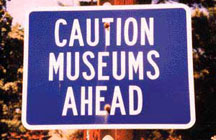| |
A Resource by Mark D. Roberts |
|
Archive December 2004
by Rev. Dr. Mark D. Roberts
Copyright © 2004 by Mark D. Roberts
Note: You may download this resource at no cost, for personal use or for use in a Christian ministry, as long as you are not publishing it for sale. All I ask is that you give credit where credit is due. For all other uses, please contact me at mark@markdroberts.com . Thank you.
Confusing Signs
Posted at 10:00 p.m. on Saturday, December 4, 2004
The introduction to a sermon called "Supernatural Signposts"
Where would we be without signs? Well, we'd be literally lost. We wouldn't know how to get around. And often we wouldn't know what to do - or not to do - when we got to our destination.
But sometimes signs aren't quite as clear as we'd like. This is especially true when we run into translation problems. Consider, for example, the following signs:
• A sign by a French swimming pool: "Swimming Forbidden in the Absence of a Saviour" [And we thought the French weren't religious!]
• In Moscow by a Russian Orthodox monastery: "You are welcome to visit the cemetery where Famous Russian and Soviet composers, artists, and writers are buried daily except Thursday." [Now that's a helpful sign. You don't want to visit the cemetery on Thursdays when the corpses aren't buried, but are walking around like Zombies.]
• In a hotel lobby overseas: "Please Do Not Use This Lift When It Is Not Working." [Good rule of thumb, don't you think? Never use an elevator when it's not working.]
• In a hotel in Bucharest, Romania: "The lift is being fixed for the next day. During that time we regret that you will be unbearable." [Now this sign must have been specially made for the American tourists.] |
|
| |
Now here's an important sign. You've always got to watch out for those museums!
|
|
| |
I don't know if this sign is confusing, but it's certainly of questionable help in drawing people to church. |
Signs, for better or for worse, they're an essential part of our life. And they're also essential in the life of the church.
The Purpose of God's Signs
When God does something unusually wonderful in our world - healing a person's body, multiplying food, raising the dead - we tend to call it a miracle. Scripture, however, prefers the word "sign." In our text today we read: "Awe came upon everyone because many wonders and signs were being done by the apostles" (v. 43). Actually, in Greek both the word translated as "wonders" and the word translated as "signs" refer to a supernatural event that points to something else. Both "signs" and "wonders" are, in effect, supernatural signposts.
Question: To what to the biblical signs point? For an answer to this question and the continuation of this sermon, click here.
Home
What Does God Look Like?
Introduction to my sermon of December 19, 2004
Posted at 11:00 p.m. on Saturday, December 18, 2004
| |
|
A few weeks ago I was studying in a local public library. All of a sudden the quiet of the library was interrupted by the mischievous sounds of ten-year-old boys. Looking up from my computer, I saw three young hooligans racing around the stacks, laughing and playing. That's great in a park, but obnoxious in a library. So I gave them my all-time toughest disapproving glare, not that I thought it would make any difference, mind you.
One of the boys saw me and darted behind one of the shelves. Then he peeked out, looking at me cautiously. Finally he approached and asked in an awed voice, "Hey! Are you FBI?"
I didn't answer. I figured I get more respect if I let him think I was FBI. And you know what? He stopped making noise in the library! |
|
|
I still can't for the life of me figure out what that boy thought he saw.
|
That isn't the strangest question I've ever received however. Fifteen years ago when I was Pastor of Education at Hollywood Presbyterian Church, I was wandering around in the Sunday School classrooms. As I entered the four-year-old class, one of the little boys looked at me with a start. I noticed that he was staring at me as I said hello to the other children. So I came up to him and said, "Hi. What's you're name?" He looked up at me with wide-open eyes and asked in a hushed voice, "Are you God?"
A Picture of God
 |
When you think of God, what picture comes to mind? Perhaps, like me, you can't avoid envisioning God along the lines of the Sistene Chapel: a giant, muscular, white-haired man with a long beard, rather like a physically-fit Santa Claus wearing a bed sheet. Or maybe you picture a king enthroned in a majestic palace. Or perhaps you remember one of the cinematic "Gods" of the last two decades. There was the George Burns "God" from the Oh, God films. Then there was the Morgan Freeman deity from the Jim Carrey flick, Bruce Almighty. Perhaps the most imaginative "God" of all was in the controversial movie Dogma. No older gentleman, the "God" of Dogma was portrayed by the Canadian singer, Alanis Morrisette. This "God" had little to say, but liked to smell flowers and stand on her head.
So, what do you think? What does God look like?
Of course I'm not really asking about God's physical appearance. God is spirit, the One Scripture reveals to be "the King of ages, immortal, invisible, the only God" (1 Timothy 1:17). What I'm interested in is not God's outward appearance, but rather God's character. When I ask, "What does God look like?" I'm wondering about the nature of God. Another way to put it would be: "What is God really like?" |
 |
 |
Jesus: The Image of God
We find an answer to this question in 2 Corinthians 4. Here Paul uses a striking phrase, referring to "the light of the gospel of the glory of Christ, who is the image of God." (4:4). The Greek word for image is one we use in English: icon (from Greek eikon). It usually means visual representation. But it also refers to something that represents or imitates the essential nature of something else. "True form" is one possible translation. Paul's point is that Christ represents to us the essential character of God. Look at Jesus and you see what God is like. Look at Jesus and you see God.
For the rest of this sermon, click here.
Home
Home
|









